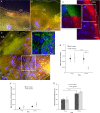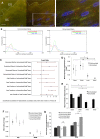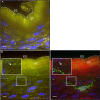Visualization of HIV-1 interactions with penile and foreskin epithelia: clues for female-to-male HIV transmission
- PMID: 25748093
- PMCID: PMC4352059
- DOI: 10.1371/journal.ppat.1004729
Visualization of HIV-1 interactions with penile and foreskin epithelia: clues for female-to-male HIV transmission
Abstract
To gain insight into female-to-male HIV sexual transmission and how male circumcision protects against this mode of transmission, we visualized HIV-1 interactions with foreskin and penile tissues in ex vivo tissue culture and in vivo rhesus macaque models utilizing epifluorescent microscopy. 12 foreskin and 14 cadaveric penile specimens were cultured with R5-tropic photoactivatable (PA)-GFP HIV-1 for 4 or 24 hours. Tissue cryosections were immunofluorescently imaged for epithelial and immune cell markers. Images were analyzed for total virions, proportion of penetrators, depth of virion penetration, as well as immune cell counts and depths in the tissue. We visualized individual PA virions breaching penile epithelial surfaces in the explant and macaque model. Using kernel density estimated probabilities of localizing a virion or immune cell at certain tissue depths revealed that interactions between virions and cells were more likely to occur in the inner foreskin or glans penis (from local or cadaveric donors, respectively). Using statistical models to account for repeated measures and zero-inflated datasets, we found no difference in total virions visualized at 4 hours between inner and outer foreskins from local donors. At 24 hours, there were more virions in inner as compared to outer foreskin (0.0495 +/- 0.0154 and 0.0171 +/- 0.0038 virions/image, p = 0.001). In the cadaveric specimens, we observed more virions in inner foreskin (0.0507 +/- 0.0079 virions/image) than glans tissue (0.0167 +/- 0.0033 virions/image, p<0.001), but a greater proportion was seen penetrating uncircumcised glans tissue (0.0458 +/- 0.0188 vs. 0.0151 +/- 0.0100 virions/image, p = 0.099) and to significantly greater mean depths (29.162 +/- 3.908 vs. 12.466 +/- 2.985 μm). Our in vivo macaque model confirmed that virions can breach penile squamous epithelia in a living model. In summary, these results suggest that the inner foreskin and glans epithelia may be important sites for HIV transmission in uncircumcised men.
Conflict of interest statement
I have read the journal's policy and the authors of this manuscript have the following competing interests: MHD received funding from Bristol Meyers Squibb through a Virology Fellows Grant for this work. They had no role in study design, data collection and analysis, decision to publish, or preparation of the manuscript. This does not alter our adherence to all PLOS Pathogens policies on sharing data and materials.
Figures




Similar articles
-
HIV infection and immune defense of the penis.Am J Reprod Immunol. 2011 Mar;65(3):220-9. doi: 10.1111/j.1600-0897.2010.00941.x. Epub 2011 Jan 9. Am J Reprod Immunol. 2011. PMID: 21214659 Free PMC article. Review.
-
HIV-1 infection of human penile explant tissue and protection by candidate microbicides.AIDS. 2009 Jan 28;23(3):319-28. doi: 10.1097/QAD.0b013e328321b778. AIDS. 2009. PMID: 19114867 Free PMC article.
-
Potential HIV-1 target cells in the human penis.AIDS. 2006 Jul 13;20(11):1491-5. doi: 10.1097/01.aids.0000237364.11123.98. AIDS. 2006. PMID: 16847403
-
Penile Anaerobic Dysbiosis as a Risk Factor for HIV Infection.mBio. 2017 Jul 25;8(4):e00996-17. doi: 10.1128/mBio.00996-17. mBio. 2017. PMID: 28743816 Free PMC article. Clinical Trial.
-
The role of the foreskin in male circumcision: an evidence-based review.Am J Reprod Immunol. 2011 Mar;65(3):279-83. doi: 10.1111/j.1600-0897.2010.00934.x. Epub 2010 Nov 28. Am J Reprod Immunol. 2011. PMID: 21114567 Free PMC article. Review.
Cited by
-
The Penile Microbiota in Uncircumcised and Circumcised Men: Relationships With HIV and Human Papillomavirus Infections and Cervicovaginal Microbiota.Front Med (Lausanne). 2020 Jul 30;7:383. doi: 10.3389/fmed.2020.00383. eCollection 2020. Front Med (Lausanne). 2020. PMID: 32850898 Free PMC article. Review.
-
Durable protection against repeated penile exposures to simian-human immunodeficiency virus by broadly neutralizing antibodies.Nat Commun. 2020 Jun 24;11(1):3195. doi: 10.1038/s41467-020-16928-9. Nat Commun. 2020. PMID: 32581216 Free PMC article.
-
Development of a repeat-exposure penile SHIV infection model in macaques to evaluate biomedical preventions against HIV.PLoS One. 2018 Mar 27;13(3):e0194837. doi: 10.1371/journal.pone.0194837. eCollection 2018. PLoS One. 2018. PMID: 29584769 Free PMC article.
-
Mucosa: Key Interactions Determining Sexual Transmission of the HIV Infection.Front Immunol. 2019 Feb 6;10:144. doi: 10.3389/fimmu.2019.00144. eCollection 2019. Front Immunol. 2019. PMID: 30787929 Free PMC article. Review.
-
Visualizing the Immune System: Providing Key Insights into HIV/SIV Infections.Front Immunol. 2018 Mar 2;9:423. doi: 10.3389/fimmu.2018.00423. eCollection 2018. Front Immunol. 2018. PMID: 29552017 Free PMC article. Review.
References
-
- UNAIDS (2013) UNAIDS Report on the global AIDS epidemic 2013. http://www.unaids.org/sites/default/files/en/media/unaids/contentassets/...
-
- Bailey RC, Moses S, Parker CB, Agot K, Maclean I, et al. (2007) Male circumcision for HIV prevention in young men in Kisumu, Kenya: a randomised controlled trial. Lancet 369: 643–656. - PubMed
-
- Gray RH, Kigozi G, Serwadda D, Makumbi F, Watya S, et al. (2007) Male circumcision for HIV prevention in men in Rakai, Uganda: a randomised trial. Lancet 369: 657–666. - PubMed
Publication types
MeSH terms
Grants and funding
LinkOut - more resources
Full Text Sources
Other Literature Sources
Medical

